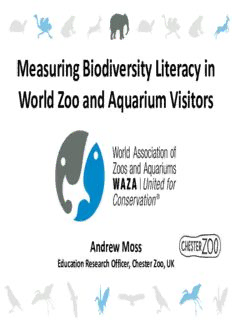
Global zoo and aquarium visitor survey PDF
Preview Global zoo and aquarium visitor survey
Measuring Biodiversity Literacy in World Zoo and Aquarium Visitors Andrew Moss Education Research Officer, Chester Zoo, UK UN Decade on Biodiversity WAZA official partner of United Nations Convention on Biological Diversity (CBD) during Decade on Biodiversity 2011–2020. Aichi Biodiversity Target 1 Target 1: “By 2020, at the latest, people are aware of the values of biodiversity and the steps they can take to conserve and use it sustainably.” Why Zoos and Aquariums? • Zoos and aquariums are truly global in their popularity. • 700 million visits made to zoos and aquariums each year worldwide (Gusset and Dick, 2011). So, huge potential to influence large numbers of people. Gusset, M., & Dick, G. (2011). The global reach of zoos and aquariums in visitor numbers and conservation expenditures. Zoo Biology, 30(5), 566-569. Project time-frame Global zoo and aquarium Educational and awareness survey tools 2012 First global survey conducted Educational tools developed 2013 First survey analysis and report 2014 Educational tools implemented in Second global survey conducted participating zoos 2015 Second survey analysis and report Global zoo and aquarium visitor survey: Methods and key findings from first survey Research Team Andrew Moss (Chester Zoo), Eric Jensen (University of Warwick) and Markus Gusset (WAZA Executive Office) International peer reviewers 30 WAZA member institutions across the globe Biodiversity Literacy Research Research Questions 1. How well do world zoo and aquarium visitors understand the term ‘Biodiversity’? 2. Do world zoo and aquarium visitors understand the actions they can take to help protect Biodiversity? 3. Can zoos and aquariums make a difference with regard to Target 1? Procedure outline • Pre-/Post-visit survey (repeated-measures) • Systematic random sampling employed. Goal was for n=300 matched pre-/post-visit surveys per zoo or aquarium • Small incentives were offered to respondents by most zoos and aquariums to encourage post-visit survey completion Survey Design Single-page design with three main components: 1. Basic demographic information. 2. Two main dependent variables, each measured by open- ended questions: • Understanding of Biodiversity • Knowledge of actions to protect Biodiversity 3. A number of potential independent variables also measured.
Description: